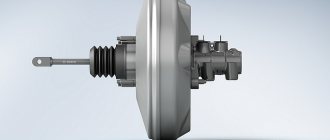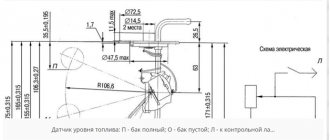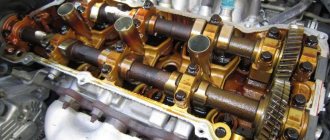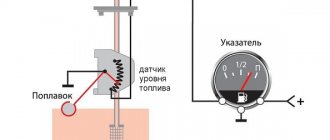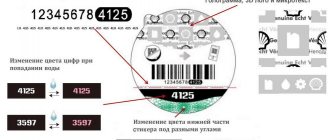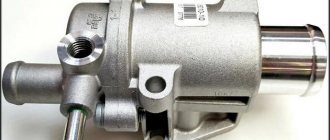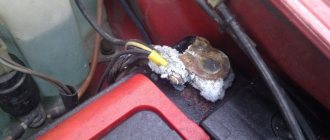06 March 2020 Lada.Online 169 504 72
Oil consumption is provided for by the engine design and cannot be equal to zero, otherwise the engine will be destroyed. At AVTOVAZ there are standards for the consumption of motor oil, and the standards are the same for all VAZ engines (starting from the VAZ 21213 engine, which is installed on the Lada 4×4, ending with modern 1.6 and 1.8 liter VAZ 21126, VAZ-21129, VAZ-21179 engines). Let's figure out how much oil a VAZ engine should consume, as well as which of the AvtoVAZ engines is the most voracious.
Why does oil consumption increase?
There are various reasons leading to excessive consumption of engine oil. To understand the reasons, you first need to determine the nature of this process, since these symptoms will make it easier and faster to identify malfunctions.
- The consumption norms were exceeded slightly, by about 15-20%.
- Heavy burning - oil consumption approaches 1 liter on short runs.
- A certain amount disappears over a short period of time (the level decreases constantly by the same value).
- The amount of oil decreases “in spurts”, periodically giving way to periods of normal consumption.
The most common reason that an engine burns oil is overheating of the engine itself. If the overheating was insignificant and the coolant did not boil, then the engine will withstand a small amount of it without significant damage to itself. When boiling has already occurred, the driver has a direct route to a car service center.
In addition, overheating of the engine leads to damage to the valve stem seals and rings. When the caps or rings are worn, oil enters the combustion chamber. The reasons leading to wear of these parts are as follows:
- presence of significant mileage;
- frequent engine overheating;
- incorrectly selected oil type or viscosity;
- overspeeding;
- Frequent engine operation at maximum power.
If there is damage to the valve stem seals and rings, the engine smokes, but this only happens under load and may not be present at low speeds and at idle.
What kind of oil does AvtoVAZ fill in the Lada Grant engine and gearbox at the plant?
Engine (Rosneft 5W-30)
From the factory, the engine of the Lada Granta is filled with Rosneft semi-synthetic oil 5W-30. There is no such oil on the market, since it contains special additives that serve for better running-in of the new engine.
Remember that the engine of a new car needs to be broken in; it certainly won’t make it any worse!
8 valve
8-valve engine (87 hp)
Appearance of the 8-valve engine (87 hp)
Main article: oil change in the 8-valve Lada Granta engine.
On an 8-valve engine, zero maintenance must be done at 2,500 km, since the valves need to be adjusted there. It is at this mileage that the oil is changed to a new one, and the old, break-in oil is drained.
Read more about how to choose a good oil for the 8-valve Lada Granta engine.
16 valve
16 valve engine (98 hp)
Main article: oil change in a 16-valve Lada Granta engine.
And on a 16-valve engine, zero maintenance is carried out only at a mileage of 15,000 km, so some owners change the oil themselves at a mileage of up to 5,000 km. But there is no definite answer here, since car enthusiasts have different opinions.
Read more about how to choose a good oil for a 16-valve Lada Granta engine.
List of replacements
List of recommended engine oils for the engine
- ZIC XQ 5W-40 (synthetic)
- Shell 5w40 (semi-synthetic)
How to choose your own motor oil?
Manual transmission (Tatneft TM-4-12 SAE 75w-85 GL-4)
From the factory, the gearbox on the Lada Granta (both existing modifications) is filled with Tatneft TM-4-12 SAE 75w-85 GL-4 oil (TATNEFT TRANSLUX TM4-12). If there are no TatNeft gas stations in your region, then most likely you will have difficulty finding this oil.
The manufacturer answers all questions via the AvtoVAZ hotline that the service life of this oil is 150,000 km, and it should only be changed to the recommended ones.
Since the issue of choosing oil in a manual transmission is a separate large topic in which there are active discussions, we will only briefly describe alternative replacements.
When should you change it?
We still recommend changing the gearbox oil at a mileage of no earlier than 15,000 km. During this time, the old oil will break in, and all the “break-in slag” will come out with it.
Alternative replacements (tested by club members)
It has been noticed that switching to synthetic oil reduces the volume of the transmission whine.
LiquiMoly 5w-40 synthetic
- Shell Spirax S5 ATE 75W-90
- Motul G300 75W-90
- CASTROL SYNTRAX UNIVERSAL PLUS 75W-90
Automatic transmission (NISSAN Matic Fluid S)
From the factory, Nissan oil (NISSAN Matic Fluid S) is poured into the automatic transmission of the Lada Granta. When checking the level on a new car, the oil color will be transparent, whereas on sale it is red, but sometimes it can also be yellow.
We have already written in more detail about changing the oil in the automatic transmission earlier.
NISSAN Matic Fluid S oil in the Lada Granta automatic transmission is filled from the factory like this
The only analogue with which it can be replaced is NISSAN Fluid Matic J (this oil is cheaper). This replacement is recommended by Nissan itself.
It is not recommended to fill NISSAN Matic D, it can break the box, members of our club had a sad experience.
In the routine maintenance of the Lada Granta, the timing of changing the automatic transmission oil is not indicated anywhere. But specifically for gearboxes, Nissan itself recommends, according to its regulations, an average replacement of 60 t.km.
Using oil that does not match the viscosity
Caps, cuffs and seals can become unusable if the additives are chosen incorrectly. Care must be taken with this choice for cars produced in the 70-80s and designed to use viscous mineral oils, and not liquid synthetics, which provoke leaks. In more modern engines designed for synthetics, pouring viscous mineral oil leads to scoring on the cylinders and rings. If you do not take into account viscosity, engine lubricant does not create a protective film of the quality required on the cylinder walls. As a result, carbon deposits form, a lot of oil burns out, and parts wear out.
The quality of the motor fluid plays an important role. Poor quality oil and unsuitable oil filters cause the engine to lose power and the car itself to smoke heavily. When purchasing lubricant, follow the manufacturers' recommendations, ask about the expiration date and storage conditions, and also do not experiment by pouring oil intended for diesel engines into gasoline engines, although some Kulibins believe that it contains more additives and provides better engine service.
Oil for 16 valve Lada Granta engine
Engine oil table
But, if you have already decided on the main features of the oil, then you can also turn to the specific parameters that relate to a particular engine. Today we will talk about the Lada Granta engine with sixteen valves. There are two such power units in the manufacturer’s range, not counting the “turbocharged” version with a power of 120 horsepower.
The oil used in a new car has a higher viscosity level. This is caused by some features of grinding the parts together. But, after that, you will need to look for a suitable oil.
However, this liquid should be recommended only in the case of cars whose mileage is less than one hundred thousand kilometers.
It, as can be understood from the index, has a slightly more suitable viscosity, which will have a good effect on increasing the density between the parts. This, of course, will not compensate for significant shortcomings in the operation of a worn-out engine, but the compression ratio will be increased.
Some of the most popular automobile oils among Grantovodov
Malfunction of the valve or channels of the crankcase ventilation system
This situation happens - compression is normal, valve seals have been replaced with new ones, but there is still excessive consumption of lubricant. Moreover, consumption is normalized when the oil level is close to the minimum. The cause may be a malfunctioning crankcase ventilation system. Exhaust gases that break into the crankcase must be sent for afterburning. But when using low-quality lubricant, the ventilation system becomes clogged. In this case, a drastic solution is proposed - purchase a flushing fluid, with which you can remove the remaining motor lubricant, and with it slag and carbon deposits, then fill in the original oil and change the oil filter. It is better to entrust this procedure to a specialist.
Changing the oil in the Granta gearbox
How to fill a Lada Granta with oil into a box is again determined by the type of gearbox. Let's start with the mechanics.
- The car is driven onto an inspection hole or overpass. Preferably after a long trip.
- The protection is removed from the drain; the edges are carefully cleaned with a wire brush.
- The plug is screwed off, and the waste is poured into an unnecessary container.
- During the process of draining the battery, the terminal is unscrewed, the fasteners securing the air filter are unscrewed, the air flow sensor and all hoses with cables that interfere with dismantling the housing are turned off.
- The filter moves to the side.
- The drain hole is clogged with a lid.
- The dipstick is removed from the filling hole and a funnel is placed in its place. Oil is poured through it.
- With the Lada in a strictly horizontal position, the level of transmission fluid is measured. The insufficient volume is replenished, the excess is drained. Drops and streaks are wiped off with a clean rag.
- Everything dismantled is put back in place in the reverse order.
At the end of the work, a test drive is done with gear shifting, and the oil level is measured again. If necessary, it is corrected.
When changing the oil in an automatic transmission, the initial steps are the same: warming up the automatic transmission, placing the car on a ramp. Your further actions are as follows.
- Using a 19mm wrench, unscrew the drain bolt.
- The overflow plug is removed with a 5mm hexagon.
- The waste liquid is drained.
- A washer-seal is installed (necessarily a new one).
- The plug and bolt are returned to place.
- A short drive is made to warm up the oil. Its temperature should fluctuate between 60 and 80 degrees.
- Without turning off the engine, the gearbox first switches from position P to position 1, and then back. In each position, the lever must be held for approximately 5 seconds.
A control check of the lubricant level is also carried out with the car body strictly horizontal. During the oil change process, all elements are wiped dry with paper or a lint-free cloth.
Poor tightening, drying out, cracking or wear of oil seal gaskets and seals
Motor gaskets are exposed to high temperatures, as a result of which they often become deformed, dry out or become cracked. The same process occurs with oil seals and cuffs. As a result, a misalignment of the oil seal causes the engine to consume oil.
When the engine is frequently operated at maximum speed and at elevated temperatures, the cylinder head gasket breaks down or burns out. If the malfunction only affects the oil channels of the cylinders, then this breakdown is difficult to diagnose, while the engine still consumes oil. To avoid this, it is recommended to change the cylinder head gaskets.
What kind of oil should I fill in after an engine overhaul for normal operation?
It must be remembered that upon completion of the repair, some characteristics of the power unit change. If professionals recommended using oil of a different viscosity on a worn-out engine, then the “rebuilt” engine should operate with the established parameters.
There are two opposing positions. Worn oil seals and gaskets leak liquid oil, so many services suggest increasing the viscosity. And vice versa - there is an opinion that thick lubricant does not pass through clogged oil lines. After the overhaul and completion of the break-in cycle, you need to return to the factory lubricant table for your car.
If your car has been out of production for a long time (this is a common thing in the case of major repairs), it can be difficult to find oil with the approval specified in the operating instructions. For example, Ford stops supporting cars that are more than 15 years old. In such cases, lubricants are selected only by viscosity, and professionals will help you choose a manufacturer.
Home page » Useful » For what reasons does the engine consume oil, what to do
How to determine the cause of increased oil consumption
To identify the causes of increased consumption, diagnose the following parameters:
- Exhaust color. Such diagnostics must be carried out by at least two people. The driver, by pressing the gas pedal or pulling out the throttle valve, increases the speed to about 2-3 thousand, and his assistant looks to see if the engine is smoking. Gray or bluish smoke indicates a problem with oil getting into the cylinders through the caps or a broken gasket. There are cases when the engine eats oil, but does not smoke. An exception may be diesel engines that produce black smoke when the gas pedal is pressed sharply, which disappears after the speed drops.
- Presence of leaks If oil stains appear under the engine of a parked car, urgent repairs are needed. A serviceable engine should not have any oil leaks or stains. If you notice a suspicious spot, you need to warm up the engine to operating temperature, periodically increasing the speed, or drive several kilometers, also alternately accelerating sharply. If the stain becomes wet and becomes larger, the problem is a malfunction of the crankcase ventilation system, poor tightening or a damaged gasket.
- Condition of the crankcase ventilation system . To do this, you need to unscrew the fastening clamps and remove the valve, then blow it out. If there is no problem, then the air will flow under low pressure and only in one direction. To prevent clogging with dirt, you need to remove and blow out all the hoses and check the pipes.
- Conditions of the cylinder head gasket. These actions are carried out after detecting bluish smoke in the exhaust gases. Even if the gasket itself does not have burnouts or visible damage, it could be deformed due to engine overheating, which does not have the best effect on its operation. This means that it is unsuitable for further use and needs to be replaced.
A drop of oil
To carry out this test you will need a blank sheet of A4 paper or filter paper. In the second case, the oil will dry out faster, and the samples here will look fresher. The procedure itself is quite simple.
You need to start the car engine and warm it up to operating temperature. After this, use a dipstick to take a sample of engine oil, a drop of which just needs to be dropped onto the paper. Next, you need to dry the material for two days. After this time, it will only take a few minutes to analyze the stain.
The material prepared in this way can already be analyzed. Here you need to analyze the following points:
- oil drop zones, their diameters;
- color and pattern of the spot;
- uniform spreading of the lubricant.
In total, four elements of the oil sample can be distinguished:
- The central part corresponding to the initial concentration of the oil drop before it begins to spread over the paper. It is here that the sediment of insoluble heavy impurities of mechanical origin is concentrated.
- An area located around the central core. It may not be present in clean motor oil after it has recently been changed. Also, if the lubricant is heavily contaminated, it is almost impossible to distinguish the edge zone due to the saturated central part.
- Diffuse area, which is a wide gray ring covering the core, marginal zone.
- The circle occupying the outermost position is characterized by the lightest color.
Using these components of an oil slick, you can quite accurately determine the condition of the engine oil. Based on such data, it is much easier to explain the reason for its increased consumption.
If the engine oil remains clean, this is indicated by a large light spot that completely disappears after a few hours. When the motor lubricant is watered, the third and fourth elements are distinguished by a ragged configuration against the background of the absence of pronounced forms. When yellow or light brown shades appear in the diffusion zone, this indicates oxidation of the oil due to critical overheating of the power unit.
A light, uniform color of the diffuse area, the core, indicates normal engine operation. If motor lubricant accumulates mechanical impurities, this is manifested by darkening of the core and diffusion zone. Against this background, the outer lighter ring expands more and more.
A thick black oily spot in the center of the drop, which contains parts of metal shavings, indicates a loss of quality properties of the motor oil. In such circumstances, its immediate replacement is required.
Thus, this simple control method allows for timely replacement of lubricants. In addition, the diagnostic options described above make it possible to take immediate action to correct problems. Timely identification of the original source of oil leaks and correction of problems prevents serious technical consequences.
Why is eating oil dangerous?
Any owner wants the car to function without interruption, the engine to serve faithfully without external interventions, expensive overhauls, which will be inevitable due to the accumulation of oil coke and its deposition on the cylinder walls, clogging of the crankcase ventilation system, wear and tear of machine components and assemblies. Therefore, it is necessary to monitor changes in oil pressure, carry out maintenance, and regularly check the dipstick readings to monitor oil consumption.
I removed the catalyst - OIL consumption increased! Why? Details + video
Not long ago I wrote an article and shot a video about why fuel consumption after the catalyst is knocked out. BUT on my channel, and in letters too, many wrote to me that everything is clear about fuel, that’s one thing, but for many, oil consumption is increasing! Moreover, even on new engines, on which the mileage is conditionally 3000 - 5000 km. Moreover, no “burrs” or any wear were noticed on them! So what's the deal. As usual there will be a text version + video...
At the beginning of the article, I would like to, as it were, cure the “CATALYST DISEASE” a little. Many owners of even new cars are itching to take them away and drive without it! The reason for this is that on some brands they can crumble and all this is sucked into the cylinders, and then hello bullies. BUT FRIENDS, you have a guarantee of at least 3 or even 5 years and 100 - 150,000 km. If you don’t put any “LEVUHA” into the tank, then there’s nothing to be afraid of, 95% out of 100!
Well, today we’ll talk about those who did this and encountered an unpleasant situation, OIL GRIND, and not just by about 1 - 2 liters per 10,000 km, it’s very unpleasant.
Reason #1 – MILEAGE
Maybe you already have 150 - 250,000 km and oil consumption began to appear even before the catalyst was knocked out! Then when you knock it out, miracles will not happen, there will be consumption and most likely it will become more.
Especially if you already have bullies, then knocking them out won’t help!
Here you need to repair, sharpen or “sleeve” the block, select new pistons, etc.
Reason #2 – ENGINE THERMAL BALANCE
I will try to explain in simple words, more details will only be in the video below. Look now, modern catalysts are installed in the exhaust manifold (and it’s all called “CAT COLLECTOR”), this is done so that it warms up faster and reaches its capacity for cleaning exhaust gases.
The escaping exhaust gases meet the surface and do not pass through it quickly, they seem to be delayed a little, creating a kind of back pressure of about 0.5 kg/cm2
Thus, back pressure + hot gases (which have just left the engine) + heating of the catalyst heats up not only the engine itself, but also the gases inside the combustion chamber. More precisely, it would be correct to say that there is no such rapid “purging” when the valves are closed .
Accordingly, there is a certain thermal expansion of both the block and the piston and, most importantly, the engine rings (oil scraper and compression).
When we knock out the catalyst, then there are NO obstacles! There is also no “back pressure”; the purging increases significantly, because when the valves close into the intake manifold, the fresh air-fuel mixture begins to be sucked in much more strongly.
Also, the temperature is not the same as it was with the catalytic collector; accordingly, the temperature drops, and the thermal gap between the wall and the cylinder block may increase. The oil scraper ring does not completely remove the oil and it burns in the combustion chamber. I hope I explain clearly.
Reason No. 3 – Crankcase gases
I already talked about them in this article ; now there is a special system of crankcase gases, that is, they do not go outside (to the atmosphere), but remain inside. A special valve (KRKG or PCV) regulates the pressure.
So, it supplies gases after the throttle valve, and they, along with the newly incoming mixture, burn in the cylinders. BUT when we remove the catalyst, then the pressure at the inlet increases, that is, the new mixture enters much stronger, and if the throttle valve closes (the gas pedal is dropped), then a “wild vacuum” is generally created at the inlet.
The valve may fail and oil, along with gases, may simply be sucked into the intake manifold.
That is, the crankcase gas system is not working properly due to the fact that there is no pressure from the catalyst.
What to do?
Personally, I see one correct solution, installing a repair catalyst . It can be welded both into the catalytic collector and into the line under the car.
However, it is in the catalytic collector that it will work correctly, create the desired temperature, as well as back pressure.
Now let's watch the video version of the article.
I think my material was useful to you, if you liked it, subscribe to the channel, and read my website. Sincerely yours, AUTOBLOGGER
(
15 votes, average: 3.93 out of 5)
Similar news
Engine flushing oil. How to choose and whether you need it or .
Turbine or compressor, which is better? And what is the difference between them? Etc.
The oil pressure light stays on for a long time when starting. Especially in the cold.
Add a comment Cancel reply
TOP articles for the month
The holidays are coming, which means most of our country will be drinking alcohol. Easy: -…
The vehicle battery voltage, as well as its capacity, are the most important indicators of this automotive unit,...
I am often asked about car emissions. Often, newbies, and even experienced drivers, don’t like…
Video on the topic:
1200 rub. for the photo report
We pay for photo reports on car repairs. Earnings from 10,000 rubles/month.
Write:
High oil consumption can occur for both serious and non-critical reasons. The first category includes the following possible malfunctions - wear of the piston oil rings, clogged breather, wear of oil seals, leakage through the gasket or seals, and some others. The simple ones include: the wrong oil is filled, the oil filter is leaking, or leaking through the valve cover.
Also, do not forget that every internal combustion engine has such a concept as “natural waste”. That is, the oil naturally evaporates during engine operation (this is especially true for mineral oils). Therefore, it is necessary to regularly monitor the oil level and periodically add it.
What kind of oil to fill in the Lada Granta engine » OLDMERIN.net
Lada Granta is the best-selling car in Russia. Over the 11 months of 2022, 180,653 copies of this model were sold on the domestic automobile market, which, taking into account the latest trends in falling car sales in Russia, is a very, very good indicator. This is achieved due to the fairly low price of the car, as well as the ease of its operation. After all, there are legends about the fact that AvtoVAZ creations can be properly serviced in any garage service, and the number of instructions on the Internet for servicing and repairing the Lada Grant is almost countless.
We will try to figure out the question of what kind of oil to pour into the Lada Granta engine. Despite the fact that on various Internet forums and websites you can find many opinions on this matter, among them you can highlight the basic points and systematize them in order to determine the characteristics of the best engine oil for Granta.
To begin with, let us remember that the Lada Granta is sold with five engine options. The eight-valve 1.6-liter engine is offered with three power options: 82, 87 and 90 horsepower, and the 16-valve 1.6-liter engine comes in two versions: 98 and 106 horsepower.
Structurally, they are all quite similar to each other and only the 98-horsepower engine has cardinal differences. The fact is that it is equipped with a valve drive hydraulic pusher and oil supply channels in the cylinder head. At the same time, these structural elements do not affect the selection of engine oil, and in official documents AvtoVAZ puts forward the same requirements for lubricants for all Grant engines.
The operating instructions for this car say that the power unit of the Lada Granta requires 3.5 liters of engine oil (in fact, the volume is slightly less, since it will not be possible to drain all the liquid), which must meet the SJ or SL approval (in rare cases, SM ) according to the API standard, or tolerances B4-B6 according to the AAI classification.
But there are times when the owner of a Grant has the desire or the opportunity to fill in oil of foreign origin, which has not been officially classified according to the above standards. In such a case, we provide a list of approvals from well-known car manufacturers, according to which you can select oil for the Lada Grant (table below).
Approvals of Western car manufacturers that meet the requirements of Lada Granta
M2C913-C (HTHS in the range 2.9-3.5)
Oils of this type can only be used for new cars.
PSA Peugeot Citroen
RN 0700 (HTHS in the range 2.9-3.5)
RN 0710 (HTHS in the range 2.9-3.5)
Oils of this type can only be used for new cars.
In addition to these compliance standards, an important role in the selection of motor oil is played by its viscosity class, which is standardized according to the SAE J 300 system. The choice here depends solely on the climatic characteristics of the region where the car will mainly be used. Therefore, we present a table that shows the correspondence of the temperature regime to the viscosity class of the engine oil for the engine.
What is normal oil waste
Before looking for the reason for the high oil consumption and the need for constant periodic topping up, it is worth understanding what value of waste is considered normal. And only then figure out why the engine began to consume oil.
Additives that reduce oil consumption
If oil consumption is high, it is necessary to repair the engine or replace the oil caps, but if the oil consumption is insignificant, special additives will help. To reduce the amount of engine oil "waste" use Hi-Gear OIL Treatment, Liqui Moly Oil Additiv or Read more
The oil burn rate depends on the type and condition of the engine. Let's start the review with naturally aspirated gasoline engines . For new engines, the rate of oil loss is about 5...25 grams per thousand kilometers, that is, approximately 0.005%. 0.025% per 100 liters of fuel burned. Occasionally you can find models in which a similar value is up to 30...40 grams (for example, V6 or V8 engines). As for normally worn engines, their natural consumption is considered to be 0.025%. 0.1% per 100 liters. That is, about 25.100 grams per 1000 kilometers. If the gasoline engine is very worn, the value increases to 0.4%. 0.6% per 100 liters, that is, 400.600 grams. The critical level is considered to be 0.8%, that is, 800 grams per 100 liters of gasoline. This engine needs a major overhaul!
Now a little about turbocharged gasoline engines . If the engine is new, then it will consume about 80 grams per 100 liters of fuel (conditionally per 1000 kilometers). As for worn-out units, the critical value is 2 liters of oil per 100 liters of fuel.
As for diesel engines , their waste consumption will be higher than that of atmospheric gasoline engines. So, it is believed that the norm is about 30.50 grams of oil per 100 liters of fuel. The critical value is 2 liters per hundred liters of diesel fuel. In this case, urgent repairs are necessary. Delaying it can lead to irreversible consequences.
What oil is better to fill in the 8-valve Lada Granta engine
Communities Lada Priora Lada Priora Club Blog Ignition coil
Choosing a good oil for the 8-valve Lada Granta engine
A little about the engine
The Lada Granta is equipped with engines that are exactly the same as those on the Priora and Kalina. Therefore, when choosing oil, you can be guided by the advice of these car owners.
There are three 8-valve engines on the Lada Granta: 82 hp. (index 11183, valves do not bend) and 87 hp. (index 11186, 21116, valve bending).
Engine 11183 (82 hp)
Engine 21116 (87 hp)
Choosing engine oil wisely
When choosing an oil, the most important thing is not to make a mistake and select it strictly according to the manufacturer’s specifications. The picture below shows the factory's recommendations (excerpt from the service book).
Engine oil table (first sheet)
Engine oil table (second sheet)
The first thing that catches your eye is the absence of Castrol, ZIC and other famous manufacturers.
Why? They didn't pay for advertising? By the way, for a 16-valve engine, which is not discussed in this article, the instruction manual for the Lada Priora car contains these oils.
By the way, many car owners try to fill in the oil that was filled in from the factory.
Opinion of Grantovodov
What do the owners of this car themselves think?
Opinions were divided. Some still do not trust the domestic manufacturer, while others, on the contrary, are inclined to believe that there is no need to overpay for a foreign brand. Opinions about the choice of oil were divided even among owners of 16-valve engines.
Let us only note that we have never seen Novoil Super oil from BashNeft or TatNeft Synthetic from TatNeft on sale, although we asked at their gas stations in our city.
There should be no problems with purchasing other domestic oils; they are presented in most auto stores and are in demand due to their low cost.
List of motor oils with reviews
MOBIL SUPER 3000 5W40
Completely satisfied, practically no oil consumption.
Good oil, practically no consumption, the engine runs smoothly and without problems. There is at least some kind of guarantee when purchasing at Lukoil branded gas stations.
ESSO Ultron 5W40 (synthetic)
When I bought it, they were afraid that the engine seals would be squeezed out. But I had poured the same oil into classics before, there were no problems, the mileage was more than 150 thousand km without capital, the engine practically did not take oil. In winter, it will be easier for the engine to start in cold weather. I change it every 10 thousand km.
Shell Helix HX7 10W-40 (semi-synthetic)
Good oil. This is not the first time I have used it in my car, there have been no problems. I buy from a specialized SHELL car oil store.
ELF 10W-40 (semi-synthetic)
I use the same oil, only synthetic, in my Renault company car, which already has over 200,000 km on it. It’s not for nothing that Renault recommends only this, a good oil.
ELF Competition STI 10W-40
Good oil. I filled it up immediately at the first zero maintenance, there were no problems with the engine, the mileage is more than 70 thousand kilometers. I recommend.
I sell oils, I can say that Castrol is now the very first in the ranking for fakes. If you buy a good one, then it will not cause you problems, if it is a fake, then at least it will burn out, at most, you will shorten the service life of your engine. If Castrol, then synthetics are better!
Synthetic or semi-synthetic
Currently there is a very extensive selection of oils
The manufacturer recommends only semi-synthetics. However, some car owners use synthetic oil, since it makes it easier for the engine to start in severe frost.
Pros of synthetic oil
- they are less affected by changes in external temperature;
- they have better fluidity at low temperatures; the lower the temperature, the better this ratio is compared to semi-synthetics;
- they have fewer additives in their composition, since most additives are synthesized at the time of production;
- Since the oil is completely synthetic, it was possible to achieve better anti-friction properties.
- due to better lubricating properties, friction is reduced, due to this the engine life should increase and fuel consumption should decrease.
Even though synthetic oil has better consumer qualities, it is still necessary to carefully monitor engine operation (vibration, speed, operating temperature (by the way, what is the operating temperature of an 8-valve engine?).
If you are interested in this issue, be sure to look below.
https://carfrance.ru
Reasons for the increase in lubricant waste in the engine
There are two main reasons why waste is increasing:
- Incorrectly selected or simply low-quality (fake) oil . It is necessary to fill the engine with oil with the viscosity and tolerances recommended by the car manufacturer. And try not to buy oils from dubious brands and untrustworthy retail outlets.
- Harsh engine operation . In particular, frequent operation at high speeds. At the same time, its temperature rises significantly, and more oil is needed for lubrication and cooling. Remember that more oil is consumed in the cold season. This is due to the peculiarities of crankcase ventilation. Therefore, to reduce waste, try to warm up the car at idle in winter!
Following these simple recommendations will allow you not only to reduce oil waste, but also to generally extend the life of the engine and its individual parts.
A decrease in oil level occurs for two reasons - due to waste and leakage (high consumption). So if the oil is selected correctly and the driving mode is moderate, then with a working engine there should not be excessive consumption. But when, under the same conditions, the lubrication decreases, it makes sense to search for the cause of the malfunction.
The engine eats engine oil, but does not smoke: what is the reason
If there really is no smoke, then the conclusion suggests itself - the lubricant does not burn out, but goes away. There are plenty of joints in the engine from which fluid under pressure can leak. This can be as small as a loose drain plug, or something more serious - for example, a sweaty valve cover. It is also possible that there is a leak, but there are no traces of it outside.
To make diagnosis easier, let’s divide all the symptoms into two groups:
- Clear leakage. When inspecting the engine compartment or area under the car, clear oily stains are found.
- Implicit leak. There are no external signs, it becomes noticeable only after dismantling a number of parts.
The leak location is clearly visible
The conclusion that there is a leak somewhere is usually made based on an inspection of a long-term parking area. Confirmation of this is oil traces under the engine. To make it more convincing, you can put a sheet of white cardboard. This will help determine the color of the liquid, and therefore find out which system has a problem. For example, a red or green spot indicates that the hydraulic booster (power steering) is leaking.
Causes of high engine oil consumption and methods for eliminating them
Let’s conditionally divide the reasons why oil consumption increases into complex ones (the repair of which is difficult and expensive in monetary terms) and simple ones. It makes sense to start diagnostics with simple ones (if there are corresponding “symptoms”).
Simple faults
Oil filter failure . This is a very common and frequent reason why the engine has high oil consumption. The breakdown can affect cars with both gasoline and diesel engines. The malfunction can be indirectly diagnosed by the oil stain that regularly forms under the bottom of the car (only during diagnostics is it important to determine that it is engine oil and not transmission oil). The reasons for this situation may be:
- the filter housing is loosely screwed (or not screwed at all);
- rupture of the filter housing (for example, if it was defective or it was simply of low quality);
- The sealing gasket has leaked.
There is only one way out - replacing the old filter and adding fresh oil. If necessary, you can clean the oil system.
Valve gasket wear . It may simply age from time or sudden temperature changes. As a rule, smudges are visible at bolted joints.
To solve this problem, you can try tightening the bolts to increase the pressure (preferably using a torque wrench). But it is best to completely replace the valve cover gasket.
Wear of the pan seal gasket . Here the situation is similar to the previous one. The engine oil pan gasket can be seen if you lift the car on a lift or work from the inspection hole. Its material becomes tanned over time and it loses elasticity. The way out of the situation is similar - either try to tighten the mounting bolts or completely replace the gasket.
Oil viscosity mismatch . In particular, if an engine is designed to use low-viscosity oils, and a more viscous oil is poured into it, then its piston rings become unable to completely clear the lubricant from the cylinder walls. And this leads to the situation already described, when oil enters the combustion chamber and its increased consumption appears. However, such reasoning is valid for engines of modern designs. For older power units, as their mileage increases, it makes sense, on the contrary, to use a more viscous oil. In any case, follow the car manufacturer's recommendations and fill the engine with the engine oil it requires!
High pressure of crankcase gases . The indicated pressure usually increases with significant wear of the engine and the elements of its cylinder-piston group. Therefore, it is necessary to diagnose the condition of the engine, the geometry of the cylinders, the condition of their coating, and so on. The first thing to do is check the crankcase gas valve (cover). If it is faulty, it needs to be repaired or replaced. And also clean the crankcase gas filter (if provided).
Typically, faulty crankcase ventilation causes increased oil loss (high carbon formation), decreased compression, deterioration of fuel combustion, and decreased oil life (its rapid contamination). After eliminating the malfunction, you need to flush the crankcase ventilation system.
If the machine is equipped with a turbine, then an increase in pressure may be caused by its failure. It is not difficult to diagnose a turbine failure; usually in such cases, its oil seal or bearings fail. To repair, you need to perform the specified elements. In the most critical cases, the entire turbine is replaced.
Complex reasons
Now let’s move on to more complex reasons why the engine “eats” oil. Usually this is a partial failure of the main engine parts. They are fraught with complex repairs, including major ones.
Wear of oil reflecting caps . The job of these small oil seals is to remove oil from the valve body. Due to their natural wear and tear (or due to constant sharp temperature changes, but less often), they lose their elasticity and cannot cope with their tasks. The grease remains on the valves and burns, depositing a thick layer of carbon deposits. Because of this, a situation arises when the car consumes oil.
In this case, the repair is not very complicated, but you will have to disassemble the engine a little in order to replace them.
Wear of piston oil rings . This is usually expressed in their significant overheating and/or mechanical wear. The main function of these parts is to prevent engine oil from entering the combustion chambers. However, during their work, they constantly rub against the cylinder walls, naturally wearing out. When wear reaches a critical value, the rings fail to do their job and some of the oil burns along with the fuel. Such a breakdown can be indirectly diagnosed by a change in the color of the exhaust gases and a change in their odor; the smell of burnt oil is added to it. This usually causes blue smoke to come out of the exhaust pipe. Ring wear can also occur due to a decrease in coolant level. Because of this, the engine gets very hot and the rings, as car enthusiasts say, “stick.”
Has the engine begun to “eat” a lot of oil?
Oh, this is an awkward situation: you are standing in a traffic jam, enjoying the music and a comfortable temperature, and suddenly, looking in the left side mirror, you discover blue smoke from the exhaust pipe.
The brain immediately begins to make financial calculations about the cost of major repairs, at the same time hoping that “these are just valve stem seals.” But, often, hopes are not justified, and the result of oil smoke is one big headache. The only thing that can please you in such a situation is that the oil has not run out yet. You come to a car shop, check the dipstick, buy and add a “liter” of oil, and just drive for a while, not paying attention to the smoke. The process of going for oil and topping it up becomes a regular weekly activity and it really calms you down for a while. But sooner or later there comes a time when you leave work on a Friday night, drive to the store to buy a pack of gloves, and lock yourself in the garage for the entire weekend. And by Sunday evening, you probably already know the reasons for the “oil gluttony.”
How to find these reasons? It is necessary to sequentially check all engine components that may contribute to increased oil consumption. The presence of diagnostic equipment will significantly speed up the process, but you can get by with a standard set of keys and arms growing from your shoulders.
Why does diesel consume oil?
Diesel engines can also burn oil. In addition to the reasons listed above (which are relevant for both gasoline and diesel engines), diesel engines have one special one. In particular, significant wear of high-pressure pump parts. As a rule, they are lubricated and cooled using a common oil system. Due to worn parts and/or gaskets, engine oil can enter the engine combustion chamber.
Indirect signs of such a breakdown, in addition to an increase in the amount of oil consumed, is the appearance of thick black exhaust smoke (similar to blue smoke in gasoline engines).
What cars was it used in?
Created in 2011, the 11186 engine is used as a power drive for several models of the auto manufacturer AvtoVAZ:
- Lada Kalina II – station wagon, sedan;
- Lada Granta (Lux and Norma equipment) – liftback, sedan;
- Lada Priora – sedan, station wagon, hatchback;
- Lada Largus – minivan, station wagon, van;
- Lada Vesta - station wagon;
- Lada XRay is a compact crossover/high hatchback.
Improved engine characteristics allow it to be used on any front-wheel drive car in the event of a swap rather than engine tuning.
A few words about turbines
Engines with turbochargers have their own operating specifics, which can result in excessive oil consumption. Thus, old turbines were cooled by the engine lubrication system. Accordingly, if the turbine breaks during operation (bearings break), it can transfer oil from the engine through the bearings. Moreover, depending on how broken the turbine is, oil consumption can be quite large, up to 1.3 liters per 10 thousand kilometers.
Also, partial failure of the turbocharger can lead to an increase in crankcase gas pressure. And this in turn leads to oil entering the cylinders directly into the fuel injection through the crankcase ventilation system. In this case, it is necessary to inspect the turbine, repair it, and, if necessary, replace it.
Where does this oil go?
As you know, all rubbing elements are lubricated with oil, without this it is impossible to imagine any internal combustion engine. The permissible oil consumption, as a rule, arises from the piston group of the engine, in this place the friction is greatest. Due to high temperatures, part of the engine oil burns out “flying out into the pipe” along with the exhaust or depositing on the walls of the combustion chamber, piston rings or valve seats.
Note: You should not take the figure I gave above, 10,000 km and 1 liter of oil, as a rule; for each car this figure can differ significantly, it all depends on the brand of the engine and its features.
Increased fuel consumption indicates engine malfunctions; very often the cause is engine wear. As a rule, it all starts with oil appearing in the ventilation system; gradually, if nothing is done, oil will appear in the air filter. The reason for this is the pressure of crankcase gases, which increases as the engine wears, and oil is pushed into the breather.
Turbocharged engines can burn oil very quickly, drying out the engine sump due to simple wear and tear on the turbine rotor bushings. That is why owners of such engines should be extremely careful and promptly monitor oil consumption, starting with the turbine.
Excessive oil consumption on new cars
Engines that have just come off the production line or that have undergone a major overhaul do not yet have all the rubbing parts in perfect alignment. Because of this, for the first few hundred kilometers the engine operates in break-in mode, when there may be microscopic gaps between the parts. It is through them that oil leakage is possible. The situation will return to normal when the parts are worn in and the engine can be used at full power.
Do not forget that during break-in you need to drive in a gentle mode , and not give the engine heavy loads (including high speeds).
Finally
In conclusion, I would like to note that monitoring the oil level in the engine is not only the direct responsibility of the car owner, but also a guarantee that the engine will operate for a long time and in normal mode. Use the oil (with viscosity and tolerances) recommended by the machine manufacturer. And remember that if the car begins to “eat” oil heavily, then constantly adding lubricant will not solve the problem at the root, it is only a temporary measure that can only worsen the situation. If a problem is identified, it is necessary to diagnose the machine as quickly as possible in search of possible causes of engine oil leakage , and, accordingly, carry out repair work.
Choosing engine oil wisely
When choosing an oil, the most important thing is not to make a mistake and select it strictly according to the manufacturer’s specifications. The picture below shows the factory's recommendations (excerpt from the service book).
Engine oil table (first sheet)
Engine oil table (second sheet)
Why? They didn't pay for advertising? By the way, for a 16-valve engine, which is not discussed in this article, the instruction manual for the Lada Priora car contains these oils.
By the way, many car owners try to fill in the oil that was filled in from the factory.
Opinion of Grantovodov
What do the owners of this car themselves think?
Opinions were divided. Some still do not trust the domestic manufacturer, while others, on the contrary, are inclined to believe that there is no need to overpay for a foreign brand. Opinions about the choice of oil were divided even among owners of 16-valve engines.
There should be no problems with purchasing other domestic oils; they are presented in most auto stores and are in demand due to their low cost.
List of motor oils with reviews
| Engine oil | Review |
| MOBIL SUPER 3000 5W40 | Completely satisfied, practically no oil consumption. |
| LUKOIL-LUX 5W40 | Good oil, practically no consumption, the engine runs smoothly and without problems. There is at least some kind of guarantee when purchasing at Lukoil branded gas stations. |
| ESSO Ultron 5W40 (synthetic) | When I bought it, they were afraid that the engine seals would be squeezed out. But I had poured the same oil into classics before, there were no problems, the mileage was more than 150 thousand km without capital, the engine practically did not take oil. In winter, it will be easier for the engine to start in cold weather. I change it every 10 thousand km. |
| Shell Helix HX7 10W-40 (semi-synthetic) | Good oil. This is not the first time I have used it in my car, there have been no problems. I buy from a specialized SHELL car oil store. |
| ELF 10W-40 (semi-synthetic) | I use the same oil, only synthetic, in my Renault company car, which already has over 200,000 km on it. It’s not for nothing that Renault recommends only this, a good oil. |
| ELF Competition STI 10W-40 | Good oil. I filled it up immediately at the first zero maintenance, there were no problems with the engine, the mileage is more than 70 thousand kilometers. I recommend. |
| Castrol (any) | I sell oils, I can say that Castrol is now the very first in the ranking for fakes. If you buy a good one, then it will not cause you problems, if it is a fake, then at least it will burn out, at most, you will shorten the service life of your engine. If Castrol, then synthetics are better! |
The main reasons why an internal combustion engine consumes oil excessively
So, below is a list of reasons why a car engine begins to eat oil too quickly and in large quantities. I would like to immediately note that this list is not complete and is made on the basis of the personal experience of many experienced owners and specialists.
- Increased wear of the piston group: compression and oil rings, as well as the cylinders themselves. The gap between the parts becomes larger, and therefore oil begins to enter the combustion chamber in relatively small quantities, after which it burns along with gasoline. With such symptoms, you can usually notice either heavy oil deposits or a black coating on the exhaust pipe. A major overhaul of the engine, replacement of piston group parts and boring of cylinders if necessary will help eliminate this problem.
- The second case, which is also quite common, is wear of the valve stem seals. These caps fit onto the valve from the top side of the cylinder head and prevent oil from entering the combustion chamber. If the caps become leaky, the consumption will correspondingly increase and the only solution to this problem will be to replace the valve stem seals.
- There are times when everything seems to be fine with the engine, and the caps have been changed, but the oil continues to fly away into the pipe. Then you should pay special attention to the valve guides. Ideally, the valve should not dangle in the bushing and the gap should be minimal. If the play is felt by hand, and especially strong, then it is necessary to urgently change these same bushings. They are pressed into the cylinder head and it is not always possible to do this at home, although most succeed.
- Oil leakage through oil seals and gaskets in the engine. If you are sure that everything is fine with the engine, and cannot understand why the oil is leaking, you should pay attention to all the gaskets, especially the pan. And also check the seals to see if they are leaking. If damage is found, the parts must be replaced with new ones.
- It is also worth keeping in mind that your driving style directly affects how and how much oil your engine will consume. If you are used to a quiet ride, then you should not have any problems with this. But if, on the contrary, you squeeze everything out of your car that it is capable of, constantly operate it at high speeds, then you should not be surprised at the increased oil consumption.
These were the main points that are worth considering if you suspect that your internal combustion engine's appetite for fuel and lubricants has increased. If you had a different experience, you can leave your comments below on the article.
Elimination of internal leaks.
If the cause of large internal leaks (fumes) is the hardening of the oil seals, we also recommend that you first try a simple and inexpensive method - the German Liqui Moly Oil Verlust Stop additive.
An important point in preventing oil leaks is the use of anti-friction additives, which reduce friction and prevent engine wear. Anti-friction additives in the engine extend its life by reducing ring wear, which will reduce engine oil consumption. You can read more about the differences in antifriction additives here.
An integral part of wear prevention is the use of the correct and recommended lubricants for this type of equipment and regular flushing of the engine before replacing lubricants, observing the recommended replacement intervals. You can select the necessary flushing here.
In addition, it must be remembered that improper operation of the fuel system contributes to accelerated waste consumption. For example, if the injectors are dirty, then they incorrectly spray fuel into the combustion chamber, which directly correlates with the amount of oil consumption (waste).
In this case, the fuel system should be cleaned, for which there is also an inexpensive and simple solution - fuel additives (in the tank). You should choose additives from well-known, reputable brands that will not only clean the fuel system, but will also do it safely for all fuel equipment. We recommend choosing fuel additives from the German company Liqui Moly. More detailed information can be read here.
RESULT
Each engine has a clearly established lubricant consumption rate. There is a normalized level of consumption and oil consumption is higher than normal. The level of consumption that does not meet established standards occurs due to two factors: external leaks and internal ones (waste). If your oil consumption is low and has only recently appeared, there are simple and inexpensive ways to fix the problem. To do this, first of all, use oil system sealant. Flushing the oil system, anti-friction additives and fuel additives will help you prevent consumption that does not meet the standards. If the consumption is higher than optimal, then this may result in other reasons for increased oil consumption, which, in turn, will lead to large expenses for engine repairs.
A driver who does not regularly monitor the good condition of the various mechanisms of the car puts not only its normal operation in great danger, but also his life. But, perhaps, the main question of the proper functioning of a car is where does the oil go from the engine? We'll dive into why this is important and what could be causing this problem.
When to sound the alarm
There are no exact norms for oil consumption, as is the case with fuel. Older car models use more oil than modern internal combustion engines. If in the first case this indicator is critical - half a liter per 1000 km, then for modernized cars this norm can be 1 liter about 10 thousand km.
But, again, this is not the ultimate truth. There are other factors that we will consider below. But the main criterion is a sharp and constant drop in the oil level over several days.
But in order to “sound the alarm”, it is necessary to notice this problem. This is the main prevention of accidents. Auto mechanics advise checking the oil level before each trip. This is a truism. The level is checked on a cold engine (during movement, the oil warms up and increases in volume). And as a result, you will not get an accurate indicator.
At the same time, if you notice a decrease in the level, it is not enough to simply add lubricant; it is advisable to try to understand why the oil in the engine is leaking. In the article you will receive tips on how to make the correct “diagnosis”.
Oil consumption according to technical specifications
It is well known that any liquid tends to evaporate. Faster or slower, that's a different question. This process is accelerated at high temperatures, which are typical for engine operation. During normal engine operation, oil consumption should be minimal. At the same time, different brands and models of cars can consume different amounts of it. If you don’t have to constantly carry a can of oil and add it not every day, but once a week, there’s no need to worry.
Oil quality
Oil consumption largely depends on its viscosity and quality. If with viscosity everything is more or less clear, the thinner the oil, the more it flows through various seals, then with quality it is a little more complicated. The fact is that most car owners prefer to buy motor oil for their engine for “cheaper” reasons.
For example, open the filler neck on your engine's valve cover. What do you see inside? That's right, black soot. Where does the soot come from? Yes, from oil. If the temperature is too high, cheap motor oil breaks down and deposits on the walls. Oil loss occurs and its level in the engine crankcase decreases. This, in turn, among other negative consequences, leads to a decrease in the oil level in the engine, which again does not have the best effect on its ability to cool in the oil pan. This means that in the future there will be even greater overheating of the engine oil. Unfortunately, the durability of an engine with such (cheap) motor oil is expected to be very low.
What happens if excessive oil consumption is not corrected?
In some cases of consumption that goes beyond normal limits, the engine experiences a lack of lubricant, which can become one of the reasons for severe contamination of the oil system, which can cause high oil consumption and significantly damage your car. Loss of lubrication leads to a drop in oil pressure, accelerated wear, a sharp reduction in service life and engine failure. Rebuilding or replacing an engine is very expensive, so excessive consumption of lubricants must be eliminated as early as possible in the early stages of the problem if you do not want to go broke on a new engine.
